Center of Attention
Visitors are in for a multi-sensory experience pulling ropes to play music at Sonos Studio

Bringing their passion for the emotional connection to sound, Sonos opened the Sonos Studio in LA to celebrate the listening experience. The new event space will host listening parties, screenings, lectures, workshops, concerts, and art installations. At their first preview event, reggae legend Jimmy Cliff shared tracks from his upcoming album and an intimate live set for the first 100 people to visit the Sonos Studio. On the other side of the room, about 100 ropes hang from a large square pegboard by LA artist Luke Fischbeck for his installation, “Center of Attention”.
Each rope ends in a colorful metal tube resembling the aglet on a shoelace. A close look at the elements of his striking sculptural piece reveals tiny wires strung through each strand that when touched emit sounds from the wireless Sonos music system rigged above the grid. Instructions for how to interact with “Center of Attention” are posted on the canted gallery walls: “Touch more than one rope to play. Each rope carries a signal which is carried through your body. Touch another person. Combine the signals. See what sounds you can find.”
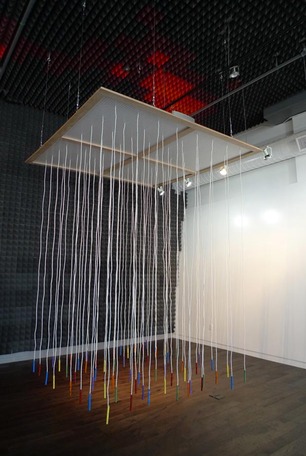
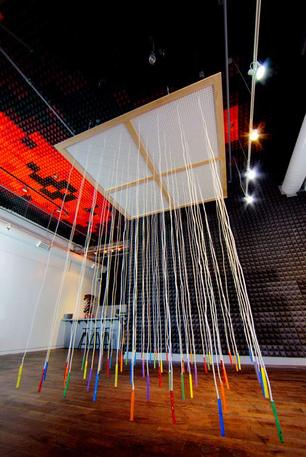
The sounds in “Center of Attention” have a mysterious, magical quality. Random tones flow together in the kind of piece that might be composed for a contemporary dance concert or modern production of A Midsummer Night’s Dream, pairing nicely in the lighthearted activity within the space. After Jimmy Cliff’s set, the crowd gravitated to the installation and interacted with it by touching the ropes and each other, playing with the different tones made by the six colors for some sophisticated, fun Twister-like game play. Deeper investigation by studio visitors inspired some hand-holding, concentrated listening and happy smiles all around, it seemed.
The playful experimenting with sound is just what the creators of Sonos had in mind when they hatched their plan to open an interactive studio space. Their new studio in the La Brea Art and Design District features everything they need to experience state-of-the-art sounds through live and recorded music, multimedia events and art installations. The custom-built pyramid-shaped red and black foam sound tiles that line the ceiling not only help the acoustic but also add a graphic element to the 4,000 square foot room.

With the intention of creating a community space, Sonos asked architect Rania Alomar of RA-DA, interior designers from The Studio Collective, Tyler King of Coffee Commissary, and furniture deisgn by Knibb Design to all collaborate on the space. Skateboarding legend Natas Kaupas also created a skateboard lending library complete with a playlist to accompany each deck.
Fischbeck’s “Center of Attention” is the first major art installation in the Sonos Studio. The artist often collaborates with Sarah Raha under the name Lucky Dragons on work exploring and experimenting with sound and touch for shows at MOCA and in the Whitney Biennial. We caught up with Fischbeck to learn more about the process behind creating “Center of Attention”.
How did the idea for the piece about?
It started as a way of trying something out, to see what would happen. I’ve been wondering about the way our sense of touch connects us through technology, as an easy way to extend ourselves into the world. On the other hand, when we touch one another directly we share a sense, actively. There’s a choice in this that is often playful, kind, sympathetic—and can bridge many differences.
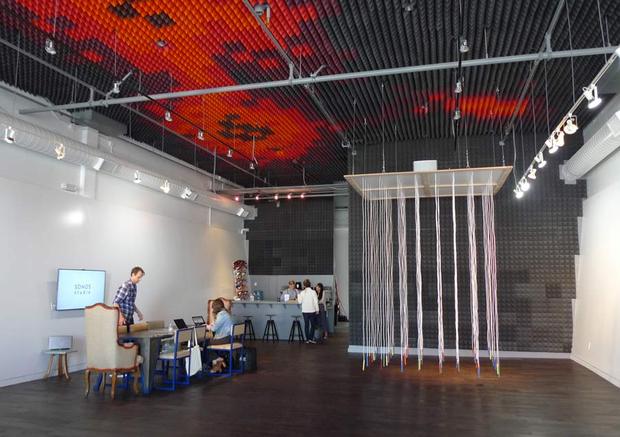
Why is the Sonos Studio the right space for this installation?
As a site-specific installation, this piece would have turned out completely differently in any other space. I was drawn to the idea of Sonos Studio as a sort of in-between space. It’s both a gathering place, defined by a series of public happenings, and a place for objects, a place to listen and touch. It’s a platform for the presentation of things, but also a thing in itself, with its own very strong identity. Visitors taking part in an event find themselves caught between engaging with one-another and engaging with things. The installation tries to build on this in-between-ness, it’s a potential performance at all times, waiting to be activated in a playful way by anyone who stops by, and until then, just a part the wild background.
What materials did you use?
Pegboard, oak, painted steel, electric fence rope with conductive wire braided into it so that it carries a current along its length, a few electronic components, a lot of connecting wire, and a computer running custom software.
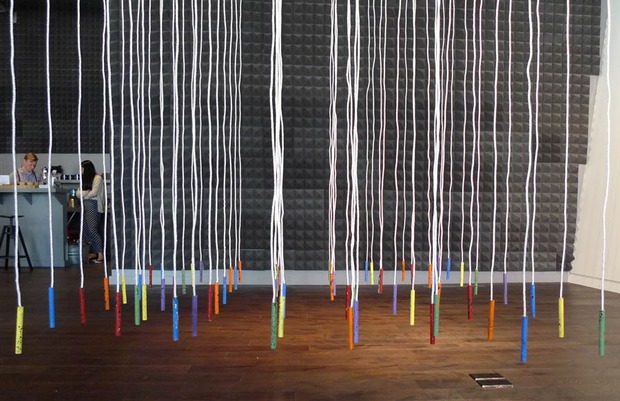
What was the process for installing the piece into the gallery?
Actually way more intense than originally planned: I’d wanted the installation to be an extension of the ceiling, hanging down almost to the floor so that it appeared to be both a part of the space and also floating independently off the ground. It turns out it takes four friends to help properly attach and align a floating rectangle! Then there was a lot of tedious wiring to get the electronics to work right, but hopefully now it just goes on its own.. until we have to take it down!
How long did the installation take from conception to installation?
There was a long quiet period after the initial idea, and then a big hurry at the end while we figured out the practical details and put it together…altogether about six months I think!
Explain how the touch activated elements work.
Each of the conductive ropes carries its own signal, a tuned circuit at an individual frequency. When you touch a rope you carry that tuned signal on your skin—touching another rope, or another person who’s also touching a rope, will combine signals, creating combinations of frequencies that are turned into sound by the software. Different kinds of touch, from gentle tickles to full grasps, affect how much of each signal is combined, meaning that each point of contact contributes to the overall sound.
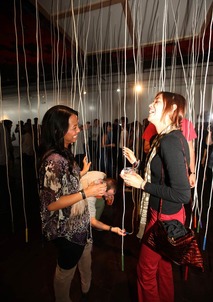
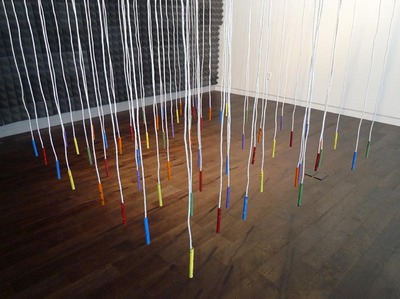
How does the number of bodies in the space change the sound?
Any number of people can play the installation directly, by touching different ropes. People can also change the sound by bridging between those playing it directly. Any point of skin contact affects the ways the different signals mix together. There’s a range of effects that can be heard, from drastic swooping melodies to very subtle changes in texture, hopefully enough chaotic possibilities that it’s fun to play with…experimenting together with other people!
What other projects are you currently working on?
A community radio station, a platform for collaborative drawing (“Sumi Ink Club“), a few light-sensitive synthesizers… we’ll see!
“Center of Attention” by Luke Fischbeck in on view at Sonos Studio 9 May—6 June 2012.












